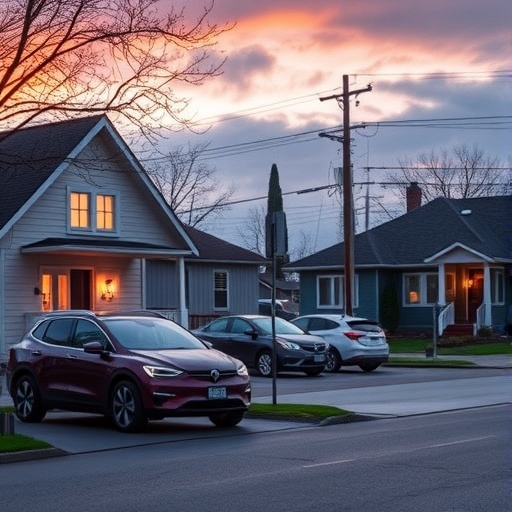A future where homes and vehicles are fully electrified poses significant challenges to the power supply infrastructure in the United States, potentially leading to power outages. Researchers from Purdue University have recently conducted a comprehensive study to better understand this impending transformation and its implications. They noted that without critical upgrades to the distribution grid, the increased load from electric heating systems and vehicles could strain the existing framework and result in massive infrastructure costs. These necessary upgrades are estimated to be between $350 billion and $790 billion, which translates to individual household expenses ranging from $2,000 to $6,400 by 2050.
The research indicates that the electrification process would involve replacing existing home heating systems, like traditional boilers, with electric heat pumps and transitioning away from gasoline and diesel vehicles toward electric counterparts. This shift, while essential for meeting climate goals and enhancing energy efficiencies, necessitates a substantial increase in electricity demand. Kevin Kircher, a mechanical engineering assistant professor at Purdue University and a key contributor to the research, elucidates that such a transition will invariably require infrastructure enhancements, including thicker wiring and more potent transformers.
Moreover, the coldest regions in the United States could see electricity demand spikes reaching five times above current peak levels, which would exacerbate the challenges utilities face in maintaining reliability. The financial burden imposed on consumers is a significant concern, as utilities tend to pass on infrastructure costs directly to customers. The implications of these costs could push the electrification benefits significantly out of reach for the average household if expansive measures are not implemented.
However, the study reveals a silver lining: strategic mitigations can significantly reduce grid reinforcement expenses by two-thirds. By adopting methods such as improving home insulation and prioritizing energy efficiency, potential financial burdens can be minimized. For instance, using ground-source heat pumps rather than air-source heat pumps can lead to greater efficiencies. Ground-source systems benefit from consistent ground temperatures, which reduce energy consumption for heating and cooling, demonstrating that not all electric systems are created equal when it comes to efficiency.
An impactful recommendation from the research emphasizes the importance of coordinating the operation of electric devices in homes. By optimizing the timing for charging electric vehicles and utilizing electric heating systems, demand on the electrical grid can be balanced to minimize strain during peak usage periods. This can lead to sub-optimal charging times for electric vehicles if not managed correctly, but with smart technology, homes could leverage their entire electric ecosystem to work in harmony.
Priyadarshan, a PhD candidate and primary author of the study, underscores the potential of integrating communication between electric vehicles and HVAC systems. The research highlights a transformative concept where electric vehicles could adjust their charging schedules to avoid simultaneous operation with heating systems, thereby alleviating grid demands during critical times. This form of coordination could realize a 40% reduction in grid reinforcement costs, demonstrating the paramount importance of smart technology in the electrification landscape.
Furthermore, this extensive study analyzed each of the Lower 48 U.S. states, modeling the effects of complete electrification on distribution grids while integrating specific data. This comprehensive approach included public surveys assessing home electricity usage, electric vehicle travel patterns, equipment specifications, building code guidelines, and localized weather data. To ensure the accuracy of their findings, researchers calibrated their model against a fully electrified test house, the DC Nanogrid House in West Lafayette, Indiana.
The model’s sophistication allowed researchers to explore various strategies for enhancing the efficiency of residential energy use and quantifying how those measures affect grid demands. By adjusting these parameters with their proposed strategies for home weatherization and equipment efficiency, the researchers aimed to devise a holistic approach for tackling future electrification challenges.
While various studies have probed into the electrification of homes and vehicles before, this research stands out due to its nationwide, county-by-county analysis. It offers unparalleled insights into local grid demands and the economic ramifications of transitioning to an electrified future. The correlation between household electrification and grid reliability is an intricate web that demands meticulous exploration, and this study begins to unravel that complexity.
The conclusions drawn from this research cast a dual perspective on the electrification phenomenon. On one hand, there is a palpable sense of urgency and concern surrounding the substantial expenses that an uncoordinated electrification effort could engender. Conversely, if electrification is approached intelligently and systematically, many of these financial challenges can be mitigated, leading to a more sustainable and efficient future.
Individuals and families across the nation can rest assured that ongoing research is seeking to illuminate the pathways of transitioning to an electrified society, emphasizing the need for innovative and cooperative solutions to make electrification both feasible and economically viable. As the country steps toward this new horizon, the emphasis will lie in fostering responsible and smart use of energy resources, ensuring that everyone benefits from the advancements in electrification without overwhelming the existing power infrastructure.
Ultimately, this research serves as a stepping stone for policymakers, utilities, and consumers to collaborate actively in crafting solutions that not only accommodate but also thrive amidst the electrification wave. Awareness of the implications, coupled with strategic implementations, will be imperative as the march toward a fully electrified society continues to unfold.
Subject of Research: Electrification of homes and vehicles in the U.S.
Article Title: Distribution grids may be a barrier to residential electrification
News Publication Date: 16-Sep-2025
Web References: Cell Reports Sustainability
References: N/A
Image Credits: Purdue University/Jared Pike
Keywords
Power distribution, Heating cooling and ventilation, Building heating, Building ventilation, Electric vehicles, Electrical machinery, Mechanical engineering.




